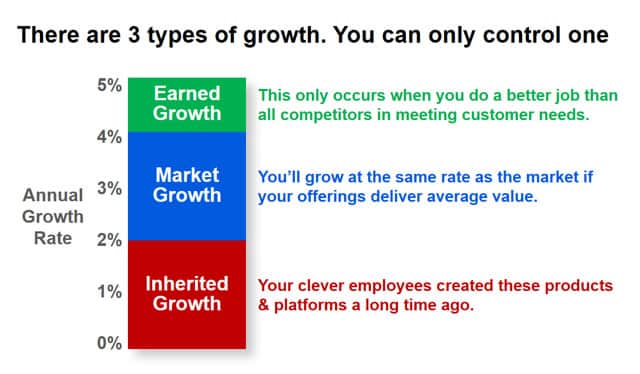Four Signs that You Have a Growth Problem

Like a good 12-step recovery problem, your first step is admitting you have a problem. Should you begin your next board meeting with, “Hello, my name is _____ and we have a growth problem”? That’s your call, but your leadership team should make sure it’s not in denial. You may have a growth problem if you have one of these four signs.
- You assume you’ll grow faster than your markets. Here’s the scene: Your market is growing at 5% annually, and you decide your business will grow at 8%. Sound familiar? What about your competitors: Will they plan to grow faster, slower or the same as the market? It’s safe to assume they plan to grow faster. So all suppliers plan to grow faster than the market they serve. As Dr. Phil would say, “How’s that been working for you?” Unless you have specific reasons for your optimism—that customers would agree with—you may not be dealing in reality.
- You don’t understand “earned growth.” Imagine you grew last year at 5%. Is there an implicit assumption you’ll keep growing this fast… that the 5% is “in the bag”? Bad assumption. Your current growth has three components, and you can only control one of them.
The first component is “inherited growth.” Years ago, your clever employees created market-winning products and platforms. They may have retired, but their gifts keep giving. Don’t count on this lasting forever. Your customers’ purchasing agents and your competitors are constantly working on ways to commoditize you.
The second growth component is “market growth.” You’ll grow at the same rate as the markets you serve if your products deliver on average the same value as competitors. Don’t take this for granted. If a competitor creates a blockbuster, you could quickly have negative growth and be wishing for market growth.
The third growth component is “earned growth.” This only occurs when you do a better job than all competitors in meeting customer needs. Thoroughly understand this component. Don’t let what you cannot control—inherited and market growth—mask problems with what you can control: earned growth.
- You’ve got the wrong time horizon. Years ago, my company president asked what I thought of a financial review meeting we’d just finished. I said it reminded me of looking at the end of an extruder. I explained that my first job as a new chemical engineer was overseeing a rubber extruder. If the material coming out of the die wasn’t in specification, I didn’t exhort the die to do better. I checked the raw material going into the feed hopper.
Everything we talked about in that meeting—sales growth, prices, gross margins—was determined by what we had put in the feed hopper years earlier. If your business isn’t spending most of its time understanding and meeting customer needs now… you won’t like what’s coming out your extruder die in a few years.
- You’re not focused on the true source of growth. Is your team mainly focusing on quality and productivity improvements? If so, do you still like disco music? Because that was also popular when these operational advances were making a real difference. The quality and productivity waves have ebbed; today’s source of competitive advantage is the innovation wave. Sure, keep improving quality and productivity, but any work on existing operations always reaches a point of diminishing returns.
Not so with customer-facing innovation, where there’s no limit to revenue potential. But it does require this mindset: The only way to achieve profitable, sustainable organic growth is to deliver more value to customers than your competitors.
Your team should ask itself two questions. First, are we delivering more value to customers than our competitors? Second, if not, why not? Perhaps you need stronger R&D capabilities and processes. Or maybe your R&D is just fine, but is working on the wrong customer problems. One recent study showed 86% of product development teams significantly changed their product design simply by interviewing customers in more advanced ways.
This is sobering… but a recovery program should be, right? Consider some good news: There’s a good chance your competitors are in denial: assuming they can grow faster than their markets… discounting their inherited growth… focusing on today’s financials… and lacking an obsession for creating customer value. But you can do much better, starting with the first step. Hello, my name is…
Written by Dan Adams, founder at The AIM Institute – author of New Product Blueprinting: The Handbook for B2B Organic Growth and has trained thousands of B2B professionals globally in the science of B2B customer insight.
Add CEOWORLD magazine to your Google News feed.
Follow CEOWORLD magazine headlines on: Google News, LinkedIn, Twitter, and Facebook.
This report/news/ranking/statistics has been prepared only for general guidance on matters of interest and does not constitute professional advice. You should not act upon the information contained in this publication without obtaining specific professional advice. No representation or warranty (express or implied) is given as to the accuracy or completeness of the information contained in this publication, and, to the extent permitted by law, CEOWORLD magazine does not accept or assume any liability, responsibility or duty of care for any consequences of you or anyone else acting, or refraining to act, in reliance on the information contained in this publication or for any decision based on it.
Copyright 2024 The CEOWORLD magazine. All rights reserved. This material (and any extract from it) must not be copied, redistributed or placed on any website, without CEOWORLD magazine' prior written consent. For media queries, please contact: info@ceoworld.biz
SUBSCRIBE NEWSLETTER









